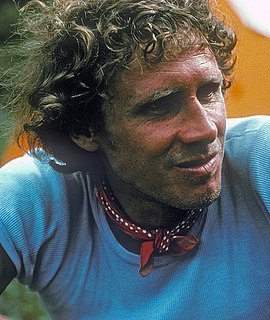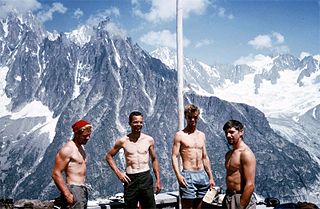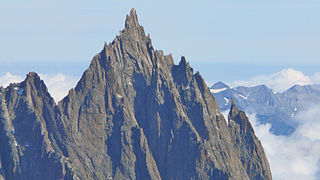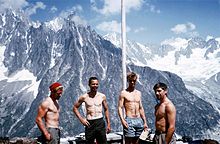
The Eiger is a 3,967-metre (13,015 ft) mountain of the Bernese Alps, overlooking Grindelwald and Lauterbrunnen in the Bernese Oberland of Switzerland, just north of the main watershed and border with Valais. It is the easternmost peak of a ridge crest that extends across the Mönch to the Jungfrau at 4,158 m (13,642 ft), constituting one of the most emblematic sights of the Swiss Alps. While the northern side of the mountain rises more than 3,000 m (10,000 ft) above the two valleys of Grindelwald and Lauterbrunnen, the southern side faces the large glaciers of the Jungfrau-Aletsch area, the most glaciated region in the Alps. The most notable feature of the Eiger is its nearly 1,800-metre-high (5,900 ft) north face of rock and ice, named Eiger-Nordwand, Eigerwand or just Nordwand, which is the biggest north face in the Alps. This huge face towers over the resort of Kleine Scheidegg at its base, on the eponymous pass connecting the two valleys.

Sir Christian John Storey Bonington, CVO, CBE, DL is a British mountaineer.
Peter Boardman was an English mountaineer and author. He is best known for a series of bold and lightweight expeditions to the Himalayas, often in partnership with Joe Tasker, and for his contribution to mountain literature. Boardman and Tasker died on the North East Ridge of Mount Everest in 1982. The Boardman Tasker Prize for Mountain Literature was established in their memory.

Duncan "Dougal" Curdy MacSporran Haston was a Scottish mountaineer noted for his exploits in the British Isles, Alps, and the Himalayas. From 1967 he was the director of the International School of Mountaineering at Leysin, Switzerland, a role he held until his death in an avalanche while skiing above Leysin.

Donald Desbrow Whillans was an English rock climber and mountaineer. He climbed with Joe Brown and Chris Bonington on many new routes, and was considered the technical equal of both.

Royal Robbins was one of the pioneers of American rock climbing. After learning to climb at Tahquitz Rock, he went on to make first ascents of many big wall routes in Yosemite. As an early proponent of boltless, pitonless clean climbing, he, along with Yvon Chouinard, was instrumental in changing the climbing culture of the late 1960s and early 1970s by encouraging the use and preservation of the natural features of the rock. He went on to become a well-known kayaker.

Walter Bonatti was an Italian mountain climber, explorer and journalist. He was noted for his many climbing achievements, including a solo climb of a new route on the south-west pillar of the Aiguille du Dru in August 1955, the first ascent of Gasherbrum IV in 1958, and, in 1965, the first solo climb in winter of the North face of the Matterhorn on the mountain's centenary year of its first ascent. Immediately after his extraordinary solo climb on the Matterhorn Bonatti announced his retirement from professional climbing at the age of 35 and after 17 years of climbing activity. He authored many mountaineering books and spent the remainder of his career travelling off the beaten track as a reporter for the Italian magazine Epoca. He died on 13 September 2011 of pancreatic cancer in Rome aged 81, and was survived by his life partner, the actress Rossana Podestà.

John Elvis Harlin II was an American mountaineer and US Air Force pilot who was killed while making an ascent of the north face of the Eiger.
Alan Paul Rouse was the first British climber to reach the summit of the second highest mountain in the world, K2, but died on the descent.

Gary Hemming was a noted American mountaineer. Together with Royal Robbins he made the first ascent of the American Direct route on the Aiguille du Dru in Chamonix in 1962, and was widely known in France for his role as a rescuer of a party on the same mountain in 1966, earning him the moniker "le beatnik des cimes".

The Aiguille du Dru is a mountain in the Mont Blanc massif in the French Alps. It is situated to the east of the village of Les Praz in the Chamonix valley. "Aiguille" means "needle" in French.
Jan Długosz was a Polish mountaineer and writer. He lived in Kraków. In 1961 he participated in the first ascent of the Central Pillar of Frêney on Mont Blanc by a British-Polish team.

Miriam O'Brien Underhill was an American mountaineer, environmentalist and feminist, best known for the concept of "manless climbing" – organizing all-women's ascents of challenging climbs, mostly in the Alps.

The Aiguille du Grépon, informally known as The Grepon, is a mountain in the Mont Blanc Massif in Haute-Savoie, France. The Grepon has a Southern and Northern peak, which are the highest points of a sharp granite ridge to the east of the Glacier des Nantillons above Chamonix and northeast of the Aiguille du Midi. A madonna statue is situated on the Southern peak.
Catherine Monique Suzanne Destivelle is a French rock climber and mountaineer. In 1992 she became the first woman to complete a solo ascent of the Eiger's north face. She completed the climb in winter in 17 hours. Her other notable climbs include the Bonatti Route on the north face of the Matterhorn, and the southwest pillar of the Aiguille du Dru. Destivelle has been the subject of several documentaries, including French director Rémy Tezier's, Beyond the Summits, which won the award for best feature-length film at the 2009 Banff Mountain Film Festival.

Jean-Marc Boivin was a French mountaineer, extreme skier, hang glider and paraglider pilot, speleologist, BASE jumper, film maker and author. The holder of several altitude records for hang gliding and paragliding, the creator of numerous first ascents and first ski descents in the Alps, a member of the team that broke the record for a sub-glacial dive and the first person to paraglide from the summit of Mount Everest, Boivin was a pioneer of extreme sports. He died from injuries incurred after BASE jumping off Angel Falls in Venezuela, the highest waterfall in the world.
Josef Knubel was a Swiss mountaineer and mountain guide. He made many first ascents and other climbs in the Alps during his career. He is best known for his ascents as a guide for Geoffrey Winthrop Young.

The 1970 British Annapurna South Face expedition was a Himalayan climb that was the first to take a deliberately difficult route up the face of an 8,000-metre mountain. On 27 May 1970 Don Whillans and Dougal Haston reached the summit of Annapurna I which at 26,545 feet (8,091 m) is the highest peak in the Annapurna Massif in Nepal. Chris Bonington led the expedition which approached up a glacier from the Annapurna Sanctuary and then used rock climbing techniques to put fixed ropes up the steep South Face. Although the plan had been to use supplementary oxygen, in the event it was not possible to carry any cylinders high enough for the lead climbers to use on their summit bid.
The recorded history of climbing of the Eiger mountain in Switzerland starts in the 1800s. Since then, at least sixty-four climbers have died while attempting the ascent.












